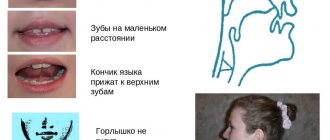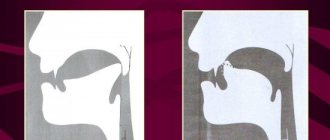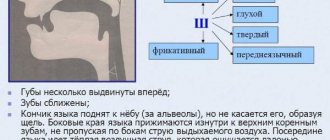Articulation of sound [C]
The sound [S] is a consonant, deaf, hard, front-lingual. Normally, by the age of four, children have formed the correct pronunciation of whistling sounds.
Articulation of sound [C] The lips are stretched in a wide smile, teeth are visible, between which there is a distance of about 2 mm. The end of the tongue rests on the lower incisors, the back of the tongue takes the “slide” position. A groove is formed in the middle of the tongue, through which a cold stream of air flows. We don't use our voice.
Corrective work
If a child pronounces sounds incorrectly, you should contact a speech therapist. He will examine the baby, determine the cause of the disorder and prescribe an effective assistance program. It is selected individually in each case. In order for a child to speak normally, it is necessary to eliminate the cause of the violation of pronunciation of sounds. In some cases, surgical correction of the speech apparatus is required. Then the speech therapist refers the child to the dentist. After this, you can begin to produce the correct speech.
Many parents worry when their child pronounces many sounds incorrectly. In this case, to correct the disorder, it is better to contact the NEAPL Speech Therapy and Psychology Center. Experienced specialists use an integrated approach to correcting speech defects using speech therapy massage, play sessions, logorhythmics, and so on. A team of professionals works on the correct pronunciation of sounds, which allows you to achieve a lasting effect.
Disadvantages of pronunciation of the sound [S]
- Interdental sigmatism . When pronouncing the sound [C], the end of the tongue falls between the teeth. This prevents the air stream from escaping. The blown air becomes warm. The resulting sound resembles [T].
- Nasal sigmatism . The tongue goes back, the lips are connected. The air rises to the soft palate and exits through the nose. Often, instead of [C], a similarity to [X] is heard. Here it is important to make sure that the child does not have rhinolalia or rhinophony.
- Lateral sigmatism . The tongue goes to the side. And not just to the side, but one edge of the tongue at the top, the other at the bottom. The distance between the teeth increases. Exhaled air flows from the sides. The sound produced resembles a “squelching”.
- Labial-dental sigmatism. The sound produced resembles [F]. The upper jaw comes forward. It turns out that the lower lip comes into contact with the upper teeth.
- Dental sigmatism . The sound resembles [T]. The end of the tongue simultaneously rests on the upper and lower incisors. As a result, air cannot escape freely.
- Hissing sigmatism . The end of the tongue goes deeper into the oral cavity, the back rises high, and a groove does not form in the middle of the tongue. A “hissing” appears. Reminds me of the sound [Ш] (shabaka).
In the case of parasigmatism, persistent replacements of whistling sounds occur. The softening is not [S], but [S'], also replacing with [T], [F]. Those. the sound does not resemble a certain one, due to incorrect articulation, and the child specifically replaces [C] with another sound.
Position of the vocal apparatus when pronouncing sounds
Lazarenko O. I., Sporysheva E. B.
Vowel sounds
Sound a. The lower jaw is lowered so that the distance between the teeth is approximately two fingers; the tongue lies flat, the tip of the tongue is at the lower front teeth; the lips form an even oval, the palate is raised; vocal cords vibrate.
Sound o. The jaw is lowered less than when pronouncing the sound a (by one and a half fingers); the lips are somewhat extended forward and rounded; the tip of the tongue is lowered and pulled away from the lower front teeth; the back of the tongue is slightly raised towards the soft palate.
The sound of The jaw is lowered to a distance equal to one little finger; the lips are pushed far forward and rounded more than when pronouncing the sound o; the tip of the tongue is moved away from the lower front teeth to a distance greater than when pronouncing the sound o, its back part is raised high to the palate; the velum is raised; vocal cords vibrate.
Sound s. The distance between the teeth is slightly less than when pronouncing the sound y; teeth slightly exposed; the tip of the tongue touches the lower front teeth, its middle part approaches the palate; the velum is raised; vocal cords vibrate.
Sound e. The lower jaw is lowered to the distance of one and a half fingers; teeth slightly exposed; the tip of the tongue touches the lower front teeth, and its middle part is raised to the palate; the velum is raised; the ligaments vibrate.
Sound and. The tip of the tongue touches the lower teeth; the back of the tongue is tense and raised towards the front of the hard palate; the vocal cords vibrate, the lips are slightly stretched and pressed against the exposed teeth; the velum is raised.
Diphthongs
Most letters of the Russian alphabet are signs of one sound. The letters e, ya, ё, yu represent two sounds: the consonant й and the vowel. For example: th+e=e; th+a=i; th+o=е; th+y=y.
For the correct sound of these vowels, you need to know what the position of the speech apparatus is when pronouncing the sound th and each of the vowels e, a, o, u.
Sound y. When pronouncing the sound th, the tip of the tongue touches the lower teeth, and the back of the tongue is tense and raised to the front of the hard palate, the vocal cords vibrate; the soft palate is raised. The th sound is pronounced simultaneously with the vowel sounds.
It is recommended to pronounce vowels alternately in the following pairs: a-z; oh; y-y; uh. At the same time, you will feel how, when moving to iotized sounds, the back of the tongue tenses and rises to the front of the hard palate; the lips, lower jaw and tip of the tongue follow the movements of the articulatory apparatus when pronouncing a, o, y, e.
Consonants
Sounds b, p. Lips tightly closed; the tongue lies freely, the tip is at the lower incisors; when pronouncing the sounds l and b, the velum is raised; a stream of exhaled air directed into the mouth breaks the closed lips, resulting in the sounds of beating; With the sound b, the vocal cords vibrate.
Sounds v, f. The lower lip, with its inner edge, slightly touches the upper teeth; the palatal curtain is raised, the tongue lies freely - the tip is at the lower front teeth; the air blown between the teeth and lip forms the sounds v and f; When sound occurs, the ligaments vibrate.
Sounds d, t, n. The tongue is slightly raised to the palate and its front part is pressed tightly against the upper front teeth; with the sound d and n, the ligaments vibrate; with the sound d and then the velum is raised; with the sound n the velum is lowered.
Sounds k, g, x. The arched back of the tongue touches the hard palate; the velum is raised; an exhaled stream of air breaks between the back of the tongue and the palate - this produces the explosive sounds k and g; if there is a gap between the palate and the back of the tongue, then a long sound x is produced; the velum palatine is raised when the sounds k, g, x are formed; With the sound g, the vocal cords vibrate.
Sounds r, r'. The formation of the sounds p and p' is caused by frequent vibrations of the tip of the tongue under the influence of an exhaled stream of air; with the sound p, vibration occurs at the alveoli of the upper front teeth; when pronouncing r', the tip of the tongue fluctuates at the front upper teeth; vocal cords vibrate.
The sound is m. The lips are slightly closed, the tongue lies freely, as when pronouncing the sound a; exhaled air passes through the nose.
Sounds l, l'. When pronouncing the sound l, the tip of the tongue touches the upper front teeth; the root of the tongue is raised; the velum is raised, the vocal cords vibrate; when pronouncing a sound, the tip of the tongue touches the upper alveoli; the whole tongue is more tense than when pronouncing the sound l.
Sounds z, s. The wide tip of the tongue touches the lower teeth and partly the lower gums, and the front part of the back of the tongue with a small longitudinal groove on it rises to the upper gums and forms a narrow gap with them; the lateral edges of the tongue are pressed tightly against the upper molars; the blown air passes along the groove of the tongue between the teeth and forms the sounds z and s; the mouth is slightly open (by 3 mm); the velum is raised; with the sound z, the vocal cords vibrate; when pronouncing z' and s', the middle part of the back of the tongue is closer to the hard palate (in the sound, this softness is expressed in a slight increase in tone).
Sounds w, sh. The wide tip of the tongue is raised almost to the edge of the upper alveoli, but does not touch the hard palate; a gap forms between the tongue and the hard palate; the lateral edges of the tongue are tightly pressed to the upper molars; the back of the back of the tongue is also raised and forms a second narrowing with the hard palate. A depression forms in the tongue (otherwise called a ladle or cup); the teeth are slightly apart, the lips are slightly moved forward; When a sound is pronounced, the ligaments vibrate.
Compound consonants
The sound ц consists of the sounds t and s, and they are pronounced without explosion and smoothly transition into the sound s.
The sound h consists of the sounds t' and sh', which are pronounced without a noticeable explosion.
The sound u is an elongated soft sound sh'-sh'. When pronouncing sh, the tip of the tongue is slightly more advanced towards the front teeth than when pronouncing sh.
Soft consonants
All consonants can sound hard and soft, with the exception of zh, sh and ts, which are never softened, and ch-shch, which are always pronounced softly.
The softness of consonants always causes significant changes in the position of parts of the speech apparatus.
When soft d, t and n are formed, the position of the parts of the speech apparatus will be slightly different than when pronouncing hard d, t and n. With the sounds t', d' and n', the tip of the tongue is at the lower teeth, and the front part of the back of the tongue tightly touches the alveoli and the front part of the palate. With d' and n', the ligaments vibrate; with t' the vocal cords are calm.
Sound setting [C].
The first stage is preparatory.
Sound production begins with preparatory work, which includes: articulatory gymnastics, development of speech breathing, establishing the level of auditory perception.
The speech therapist needs to know that the child differentiates sounds. If speech breathing is poorly developed, then difficulties may arise during sound production. And, of course, the most important part of preparation is articulation gymnastics. The development of articulation of the speech apparatus is an excellent way to prepare the speech organs.
Examples of articulation exercises for whistling sounds:
1. "Smile." The lips are very stretched in a smile. The teeth are hidden.
2. "Frog" . The child smiles widely. The teeth are visible and closed. Hold the position for about ten seconds and rest. Repeat 5-7 times.
“We imitate frogs,
We pull our lips straight to our ears.”
3. “Brushing our teeth.” Smile, open your mouth slightly, and use the tip of your tongue to “brush your teeth.” We move the tongue along the inside of the lower teeth. It is important that the tongue slides closer to the gums, and not along the edges of the teeth. The jaw is fixed.
4. “Swing” . Smile, mouth slightly open, tongue alternately rises and falls, the tip of the tongue rests on the incisors (upper and lower, respectively).
“The children sat on the swing and flew higher than the spruce tree. On the swing up and down, don’t be lazy about swinging.”
5. “Punish your tongue.” We open our mouth slightly, place the tongue on the lower lip (we try to relax the tongue, remove tension). We begin to spank it with our lips, saying “five-five…..”. You need to hold your tongue relaxed for about 10 seconds. “Clapping” occurs with one exhalation.
6. "Slide". We open our mouth. The tip of the tongue rests on the lower incisors. The back of the tongue is raised up.
7. “The ball is in the goal.” We stretch out our lips with a straw and blow on a “ball” made of cotton wool into an improvised goal. The peculiarity of this exercise: the ball must hit the goal with one exhalation. Also make sure that children do not puff out their cheeks.
Techniques for developing speech breathing can be found in the article “Development of speech breathing in preschool children.”
The time allotted for articulation gymnastics is on average 5 minutes per lesson. It is better to do it several times during the day. You shouldn’t immediately introduce your child to all kinds of exercises. Choose 3 tasks and practice them. Working on the articulation of the speech apparatus is working on the muscles and it requires effort from the baby. Do not forget that all exercises must be performed in front of a mirror so that the child can see whether he is doing the exercise correctly.
The second stage is the actual production of the sound [C].
There are three methods of sound production: by imitation, production from reference sounds, production with mechanical assistance (probes, cotton swabs, spatulas). Often there is a mixed method.
The imitation technique is suitable if there are minor defects in sound pronunciation or the sound [C] is absent. A mirror is required during the lesson, as the child must see your articulation and his own.
- Invite your child to smile widely so that his teeth are visible.
- We tense the tip of the tongue and rest it on the lower incisors.
- Ask your child to blow (on a balloon, into a bottle, on a feather) and you will hear the sound [C]. For preschool children, it is important to have a playful moment.
Labial-dental sigmatism - try to pronounce [S] with lips parted and teeth exposed. The lower lip should not “go” up. You can hold it with your hand. The exhaled speech stream should not go into the cheeks. We practice interlabial blowing (into a bottle, onto a candle). Invite your child to smile and blow - this results in interdental blowing. The next step is to hide the tongue behind the lower incisors.
Interdental and subdental sigmatism. Mechanical action is required. Press the tip of the tongue with a cotton swab and hide it behind the lower incisors. Hold your tongue and ask your child to blow and then say [C]. First separately, and then in a syllable. In the case of hissing sigmatism, interdental blowing is used, “snorting” into the tongue. Then we practice interdental pronunciation [C] of syllables, words and phrases. The tongue should fix the required position. After this, we move its tip behind the lower incisors.
With lateral sigmatism: interlabial blowing, interdental blowing, interdental pronunciation [C] in syllables, words, sentences. Then, using mechanical action, we move the tongue behind the teeth.
Nasal sigmatism. Here you need to develop an air stream in the center of the tongue (blowing on a candle, cotton wool). We start by practicing interlabial blowing, then interdental blowing and pronunciation of [C] in syllables, words, phrases. We move the tip of the tongue to the tooth position.
Setting the sound [C] - “whistle” technique.
There is a technique for setting [C], which is suitable for all types of sigmatism.
Let's call it "whistle". The mechanical effect on the tongue is exerted by the child himself with the help of his finger. What is the essence of this method? The preschooler places his index finger (about 2 centimeters) on his wide tongue, which lies behind his lower teeth. He bites his finger with his upper teeth. Conventionally, he has a “whistle” in his mouth. At the same time, the lips are stretched in a wide smile, in which the teeth are clearly visible. The speech therapist offers to blow on the child. The organs of articulation must remain fixed. With this method, it is better to fix [C] in reverse syllables.
The third stage is consolidation and automation.
Establishing the correct pronunciation of an isolated sound is only the beginning of the journey. Now it is important to automate it. Automation is happening gradually.
Examples of tasks and exercises for automation:
• Syllables for repetition reflected SA - SA - SY SA - SY - SA SY - SA - SY
AS - OS - US US - YS - AS
SVA SMO SPA (choose those sounds that the child pronounces correctly) SVO SMU SPU
• Learning pure sayings. Sa - sa - sa - the wasp is flying. Su - su - su - did you see the wasp? Sy - sy - sy - no wasp. (the child can pronounce the syllables, and the speech therapist can continue the sentence. Then you can switch places).
• “Choose and name.” The preschooler has pictures in front of him. His task is to select and name those that depict food products. (juice, sugar, sofa, cheese, soup, chair).
• Words to repeat reflectively. Juice, Sonya, owl, sock, piece, falcon, forest, voice, wheel, sun, beans.
• “One is many” An adult says the word in the singular, children in the plural). Juice - juices dog - dogs pump - pumps
• “Finish the sentence.” The adult begins the sentence, and the child finishes by finding the corresponding picture.
An owl sits on a branch. (Pine) grows in the forest. Sonya drinks (juice).
• “Call me kindly.” (dog - doggie, owl - owl).
• Working with a plot picture. Select the picture based on the sound you are working on. And ask relevant questions.
Causes of sound pronunciation problems
If the baby pronounces a number of sounds incorrectly and indistinctly, then it is worth being examined by a neurologist and speech therapist. The causes of problems with sound pronunciation may be different. However, it is necessary to identify the problem in a timely manner in order to select an effective correction program.
Dyslalia can occur due to:
- pathologies of the development of the speech apparatus (malocclusion, short frenulum, etc.);
- presence of two languages in the family;
- incorrect approach to the development of a child’s speech (communication in a “lisping” language);
- hearing loss;
- problems with sound pronunciation in one of the parents (children tend to tremble).
Dysarthria develops with damage to the central nervous system, which can be caused by:
- problems during intrauterine development;
- injuries during childbirth (umbilical cord entanglement, etc.);
- cerebral palsy;
- Rhesus conflict;
- serious infections that the child suffers;
- problems with blood circulation in the brain;
- brain injuries.
Even serious problems with the pronunciation of sounds can be corrected. However, many parents have one question. If sound pronunciation can be corrected, then why do many adults speak incorrectly? This is due to two factors. Some parents believe that there is nothing wrong with the incorrect pronunciation of certain sounds. There are also cases when they begin to provide assistance without identifying the cause of the speech defect. Naturally, correction of dyslalia with dysarthria will not have an effect.










